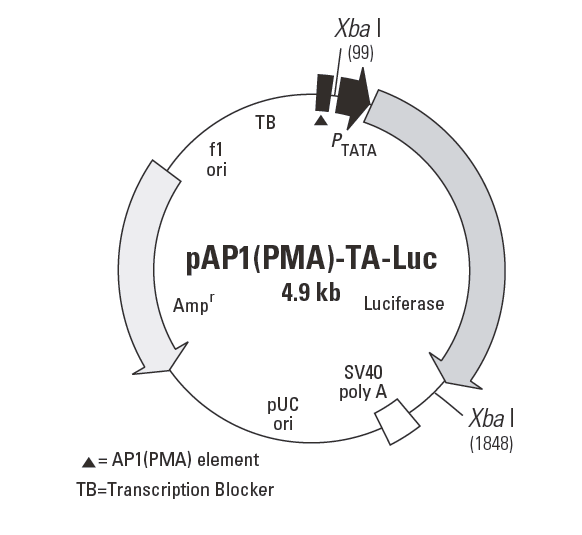pAP1(PMA)-TA-Luc 载体
| 质粒类型: | 信号通路报告载体 |
|---|---|
| 克隆方法: | 多克隆位点,限制性内切酶 |
| 载体大小: | 4.9 kb |
| 载体抗性: | Ampicillin (氨苄青霉素) |
pAP1(PMA)-TA-Luc is a member of the signal transduction reporter vectors. It is designed for monitoring the induction of the protein kinase C (PKC) signal transduction pathway, as well as related pathways such as the MAPK pathway. pAP1(PMA)-TA-Luc contains the firefly luciferase gene (luc) as the reporter. The vector contains multiple copies of the activator protein 1 (AP1) enhancer, located upstream of luc, that responds specifically to phorbol ester treatment (1). AP1(PMA) is fused to a minimal TA promoter, the TATA box from the Herpes simplex virus thymidine kinase (HSV-TK) promoter. The luciferase coding sequence is followed by the SV40 late polyadenylation signal to ensure proper, efficient processing of the luciferase transcript in eukaryotic cells. A synthetic transcription blocker (TB) is located upstream of AP1(PMA), which is composed of adjacent polyadenylation and transcription pause sites for blocking nonspecific transcription (2). The vector backbone also contains an f1 origin for single-stranded DNA production, a pUC origin of replication, and an ampicillin resistance gene for propagation and selection in E. coli.
载体应用
Activating the protein kinase C pathway by adding phorbol esters such as PMA results in transcription factors binding the AP1 element on the vector and initiating transcription of the luciferase reporter gene. Firefly luciferase is a highly sensitive enzymatic reporter that can provide quantitative data on induction levels using any standard luciferase assay. The pAP1(PMA)-TA-Luc Vector can be transfected into mammalian cells by any standard method. Stable cell lines expressing this construct can be developed by cotransfecting with a vector containing an antibiotic resistance gene, such as neomycin, hygromycin, or puromycin, and selecting resistant clones.


